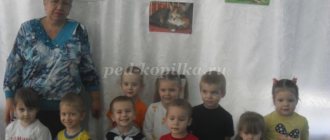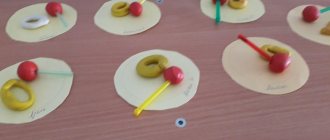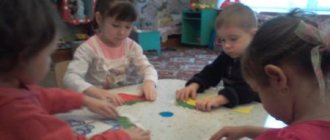Notes on ecology in the junior group “Little friends of nature (insects)”
Transcript
1 Municipal budgetary preschool educational institution “Kindergarten 13” Notes on ecology in the junior group “Little friends of nature (insects)” Educator: Nekrasova N.A. G. Sasovo, 2017
2 Purpose: 1. To expand and consolidate children’s knowledge about insects: butterflies, ants, bees - their habitat, characteristic features, behavior in nature, their benefits. 2. Introduce children to the general concept of “insects”; activate the words in children’s speech: nectar, beehive, anthill. 3. Teach children not to harm beneficial species of insects, and also to be able to see and enjoy the beauty of everything living on earth. Preliminary work: conversation, looking at insects on a walk, watching the film "The Ant Hurries Home", looking at illustrations, d/i "Little Country", p/i "The Bear and the Bees", reading fiction, asking riddles, listening to P. I. Tchaikovsky "Spring" from the cycle "Seasons". Material for the lesson: On the easel: a forest clearing (flowers, grass, butterfly, ant, bees; beehive, anthill mound. Bee caps for each child, bear mask. Lesson progress: To the soundtrack of P. I. Tchaikovsky "Spring" from the cycle " Seasons" I read the quatrain: In the clearing, by the path Blades of grass are breaking through. A stream runs from a hillock, And snow lies under the tree. V. Zakhoder - What time of year do you think this poem is talking about? That's right, spring. And when spring comes ? (after winter). How is spring different from winter? Well done, you answer correctly: The sun is getting brighter, it warms up more, the snow is melting, young grass and flowers are appearing on the ground, bugs and worms are starting to wake up. - Children, look all here. Before we have an unusual, beautiful clearing, Tell me what grows in the clearing? (trees, flowers, grass). - Do you think anyone lives here (bugs, spiders, butterflies). - Who needs flowers? (bees, butterflies )
3 -That’s right, and here a beautiful butterfly has flown into our clearing. What flower did she sit on? (chamomile) Chamomile, chamomile, fragrant flower. Yellow center, White petal. -The butterfly landed on the daisy and froze, as if falling asleep. In the spring, as soon as the sun warms up, the butterfly is right there, it flies out first. And everyone is happy about her, because she brings spring on her wings. Let's look at a butterfly: -Look what wonderful creatures insects are, how beautiful and graceful they are. They have six legs, wings, antennae on their heads and large eyes. Because of the extraordinary beauty of insects, children catch them. and they die painfully, losing their attractiveness. There are fewer and fewer beautiful large insects in nature. They cannot be caught or destroyed. (After such a conversation, I invite the children to fly like butterflies. The children “fly”, waving their arms and having great fun. At this time I say that butterflies need not be afraid of anything, children know that they cannot be touched.) - Now look here here. Here, under the tree, there is a big city, where everyone is busy with their work. In a clearing near the fir trees, a house is built from needles. It is not visible behind the grass, but there are a million residents in it. - Who works here? (ants). That's right, ants are working here. Look how big their house is! It's called an "anthill". Let's all repeat it together - anthill. “On a bright sunny day, work is in full swing here. The ants are in a hurry somewhere, hurrying, entering and exiting through round holes - gates - on the surface. Ants are small but hardworking. -Look, a bird flew in and sat on an anthill. Why do you think she is sitting on the anthill? Children, ants heal birds. They pull out small bugs from her wings that are bothering her.
4 Ants are harmless, useful inhabitants, they are the orderlies of the forest. Therefore, anthills cannot be destroyed. -We will now imagine ourselves as ants and collect all the branches in a heap, making our own anthill. (I’m playing the game “Assemble an anthill”; 6 children walk around the group and collect “branches” cut out of cardboard.) - Z-z-z. The housewife flies over the clearing, fusses under the flower, and shares the honey. -Who flew into the clearing? (bee). Where does the bee live? (in the house) - Yes, each bee lives in its own house. This house is called a beehive. What is the name of this house? (children's answers). - You see, the bee flies from one flower to another. What is she doing? (collects honey). — The bee collects nectar from these flowers. Nectar is a fragrant, sweet liquid. The bee then makes honey from it. Sweet, tasty honey is very useful for children and adults. When we are sick: we cough, sneeze, or have a sore throat, we can treat ourselves with honey. Now let's play the game "Bees and Bear." Bees collect honey from flowers. Teddy bear also loves honey. He approaches the hive house where the bees live and wants to take their honey from there. The bees fly away from him. I will be a mother bee. You will be baby bees. We will now choose a bear as a counting rhyme: “One, two, three, you will be a bear!” “(I put a mask on the driver. The bear stands aside.) The words of the mother bee: The bees have flown to collect honey from the flowers. The bear is coming, He will take the honey away from the bees, Bees, go home! Movements:
5 (The bees fly away (children run around the room, waving their arms) and buzz. The bees fly into the hive (corner of the room). The bear heads there too.) Words of the bees-children: This hive is our house, Get away, bear, from us: F- w-w-w-w-w Movements: (The bees flap their wings, driving away the bear, and fly away from him. The bear tries to catch them.) - Look, guys, at our clearing: where have all the insects gone? (fly away, hide) - Who were they afraid of? (bear). -Guys, let's draw a house for each insect. (To the accompaniment of music, I invite the children to draw houses on their own, first repeating the new words again.) - The insects will find their places where they live. Butterflies, bees, ants - they are all our little friends. They need to be protected. because they benefit nature.



